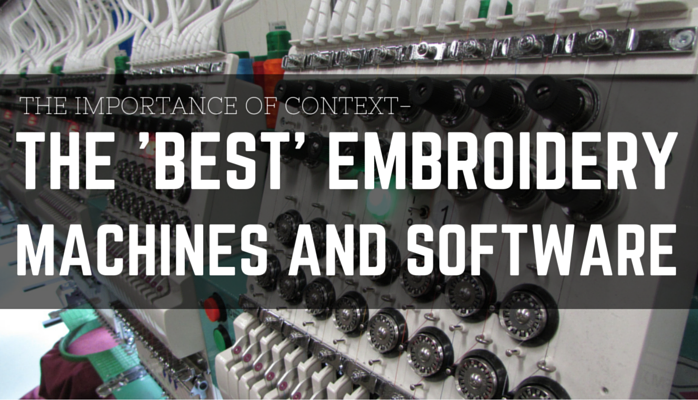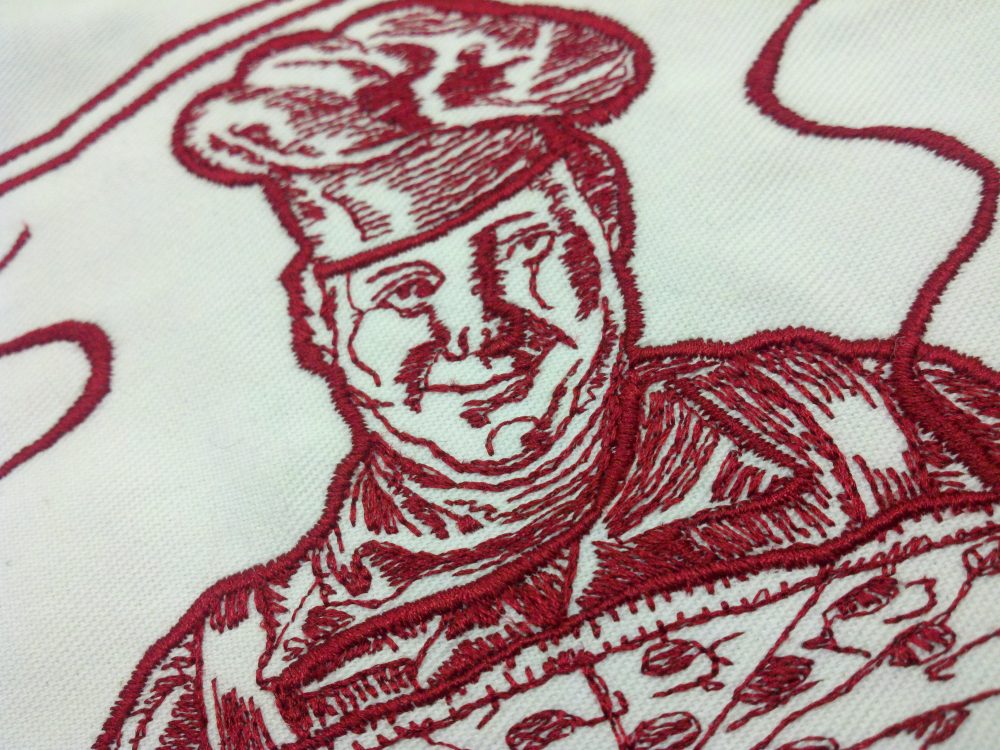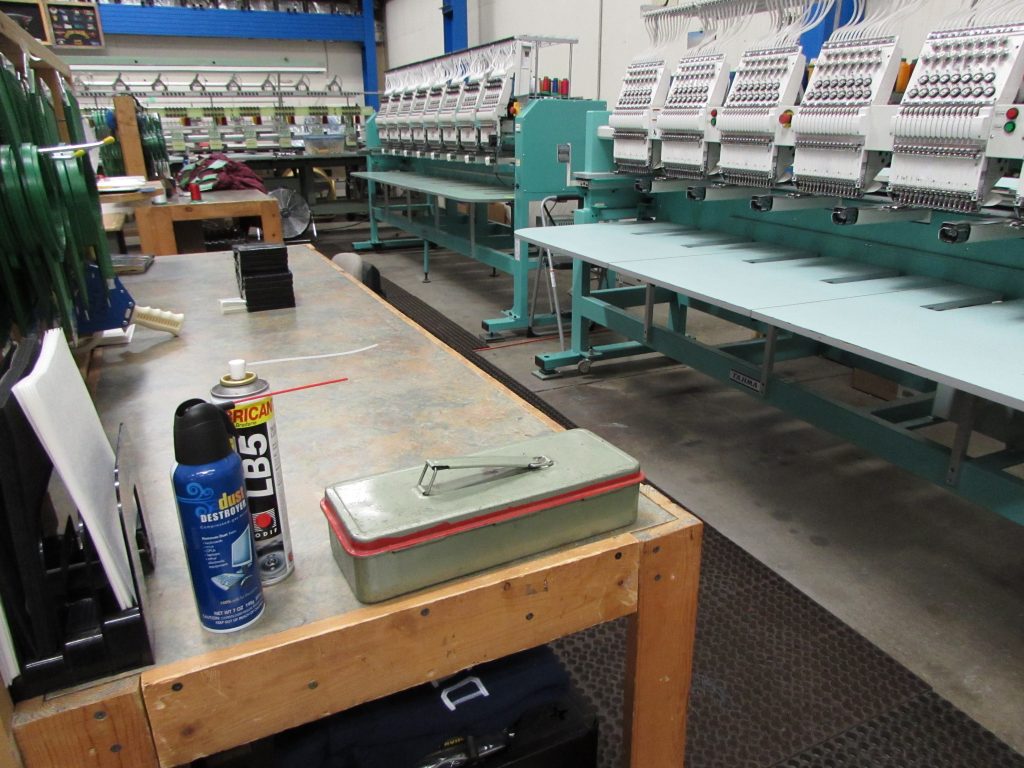
I take a deep breath whenever I hear either of these questions from someone who is new to this business:
- What’s the best embroidery machine I can buy?
- What’s the best embroidery digitizing software?
These seem like simple questions, but they are absolutely loaded. I tend to be pretty agnostic with my tools and supplies; If I find a tool or supply that fills my need, I will use and praise it accordingly, no matter who makes it. Despite my attempts to present a fair case for the pros and cons of multiple tools, someone invariably demands that I reveal which product is actually ‘the best’. The reason I dislike these questions isn’t that I am so even-handed as not to have ‘favorites’, I most certainly do; anyone who follows me long enough will see that I have preferences and biases built around my experiences in the industry just like any of my peers. Reputation and track record from a vendor make a big difference, but that alone can’t tell the entire story. Though I know my ‘bests’, the trouble with determining universally ‘best’ tools is that the ‘fitness’ of tools is determined greatly by the context in which they must perform and the systems in place to support them.
First, a biological example of context determining ‘fitness’: I can gain weight by lightly inhaling the aroma of a dish, while a friend of mine can’t put on an ounce while forcibly running himself through a gauntlet of hot fudge sundaes. In a context where rich foodstuffs are constantly available, he has a higher level of fitness; no matter how much he eats, he maintains a healthy weight. Now let’s change the context; if food became scarce, my ‘efficient’ system might keep me moving while his voracious appetite would have him painfully hungry. In that context, I might have the higher ‘fitness’. Believe it or not, that contextual argument works for embroidery machines and digitizing software.
How then, can we determine which machine is the best?
Most people who ask me this are just starting in the business and their orders largely consist of standard commercial logo work on staple garments. As such, any number of machines from the recognized brands they ask about will perform ably. One or the other will have an edge in some types of embroidery- one can fit into a tighter spot for pocket and sleeve embroidery, one has better attachments, one has finer tension control, but all of the options the petitioner presents me will suitably stitch a corporate logo on a placket shirt or polo. If the person asking the question doesn’t have a need that one machine addresses better than the rest, the decision becomes difficult. In the case of such a close call, we can determine the winner with context.
When multiple machines are affordable and suit your production needs effectively, it’s the one which will be able to be operated, maintained, and repaired at the lowest cost and with the most ease over time that wins. This seems like something you could easily measure, but remember, many of these qualifications are dependent on things that can’t get packaged in the crate with the machine.
The support system is a critical part of the ‘fitness’- If you don’t have adequate documentation, your machine becomes harder to maintain and operate. If you can’t get a technician to visit your geographical region or don’t have other shops to split costs on a tech’s travel circuit, travel costs may drastically increase your repair bills. If parts aren’t readily available for your machine, you may not be able to repair your machine at all. A machine can run well when freshly installed and still become costly to operate over time if it is not well-documented, properly supported, and if there aren’t enough parts and people available to repair it.
What about the digitizing software? Which one of those packages is best?
I’ve seen masterpieces made by digitizers using any number of software suites. Moreover, I digitized one of the finest pieces of my career stitch-by-stitch on an ancient DOS system that I wouldn’t consider using, let alone purchasing, now. The tools don’t necessarily determine the quality of the finished piece

This represents about 1/10th of that original jacket back, and every stitch was set by hand.
When someone asks me which software ‘makes better embroidery’, I answer that it’s the knowledge, practice, and creativity of the digitizer/designer that most determines the quality of the design. The tools can, however, make the process easier, faster, or more intuitive. If a package can do those things for your workflow- that may be your ‘best’ suite. There are tools specific to each package that one may prefer and the quality of the stitch generation can differ among packages, but most work won’t hang on small differences in fills or on specialty treatments. The fit is largely based on whether the tools in the software are suited to your product offerings and whether or not they help you to be more efficient.
If you are a team-sports shop, automated team naming will make a difference. If you are adding rhinestone multimedia decoration to your in-house options, rhinestone design modules might be the thing that tips the scales. If you are a gift-shop monogrammer, a lettering system that makes monogramming fast and simple will likely be your ‘best’. These tools aren’t equally important to every shop, but they may make or break the experience in your particular context.
Just as it is with machines, the resources surrounding your software will hugely affect your experience. A lack of documentation and/or educational resources can make the software harder to learn. A lack of updates may make it impossible to run on newer operating systems. A lack of interoperability with other software, services, or even specialty machines may make your production slower or make it hard to manage the mix of processes in your shop. Poor or inconsistent support on the vendor’s part may make operation or installation difficult if problems arise. A lack of vocal user communities may mean that you’ll be on your own for solutions that aren’t covered in the manual. Software that isn’t feature-complete or that doesn’t allow for future expansion may mean a costly shift to a new package later. Seemingly serviceable software can become unsatisfactory if the support system behind it isn’t solid.
In short, nothing lives entirely out of context; the next time you’re determining the ‘best’ of any tool or material, consider how it will be used, who will support it, and how it will integrate into the larger ‘landscape’ of your shop. Determine what a new purchase needs to do specifically for your situation in order for it to be a successful addition to your production line, and when more than one machine or software package can fulfill those needs, look to those somewhat ‘intangible’ qualities that come from the company that creates the item or the community that uses it. Research more than price and features- look into real world experiences from people doing the kind of work you want to do and look for that ‘ecosystem’ of resources and people that operate the tools before you buy. The benefits and costs of a product aren’t always evident in the sales ‘brochure’ text alone.
(Click the link below to read my latest article on the subject from Images Magazine UK!)









Yes, but what’s the best machine and software? Never mind, just kidding. Good article, I feel the same way.